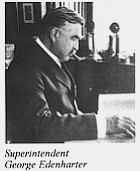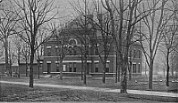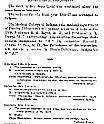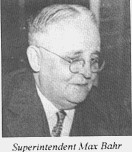Central State's Medical Staff and the Emergence of Scientific Medicine: 1890-1920

George Edenharter, CSH Superintendent from 1893-1923 (32.1 kb)
In the early 1890s, Superintendent Edenharter, seeking recognition from the medical community and hoping to expand medical research at CSH, lobbied for funds to construct a hospital pathology laboratory. Edenharter was a well-connected man who had served on the city council for four years and had run for mayor. Due to the paucity of legislative records from this period, the particulars of how funding was secured and funneled to CSH for the construction of the pathology laboratory is unclear.
It is reasonable to assume, however, that Edenharter, a man of considerable political clout, played a significant role. Edenharter skillfully married the pathology department with state medical education. A new state-of-the-art pathology department would make CSH the Indiana center for the scientific study of mental illness. Medical students from the Medical College of Indiana and the Central College of Physicians and Surgeons, as well as practicing physicians, would be invited to attend classes at CSH. In turn, physicians educated at CSH would provide better treatment for the mentally-ill patients in their care and most importantly, would possess the knowledge to diagnosis mental illness in the early stages and thus, strike a cure. If early diagnosis meant higher rates of recovery, then fewer mentally-ill people would become wards of the state. In the long run, Edenharter argued, the pathology department would save Indiana tax dollars.
Edenharter was victorious. In 1896, the pathology building, complete with an amphitheater, pathological museum, dissection and autopsy rooms, library, photography room, and three laboratories, was opened for scientific research.

CSH's Pathology Department, early 1900s (74.8 kb)
Did the pathology department live up to Edenharter's expectations? The department did fill its mission to educate Hoosier physicians, but failed to translate patient autopsies and preserved specimens into original research and progressive treatment.
 Partial List of Courses Offered at CSH, 1906-07 (78 kb)
Partial List of Courses Offered at CSH, 1906-07 (78 kb)
Dr. Edward J. Kempf, a CSH physician, attested to the failure of the pathology department in his disturbing account of conditions at CSH in 1912. When asked by the Legislative Visiting Committee what influence the pathology department had on the rest of the hospital, Kempf exclaimed:
"There are four pathology reports. Good if well done, but the last one not accurate. Padded. Reports of autopsies put in that, that are not scientific, they are so thoroughly incomplete. The great part of the report is devoted to scientific treatment of patients, not one whit of it used in the institution. Letters from eminent men (lauding CSH) are based on the reports and not on the work the institution is doing. The Hospital is utterly devoid of any scientific interest from superintendent on down."
Kempf did exclude Dr. Max Bahr and Dr. Everman from this statement, as they were also struggling to bring science to CHS. But unlike Kempf who was fired for "instituting a revolutionary movement against the management", Bahr's and Everman's reticence insured they would keep their jobs.
While we could dismiss Kempf's statement as hyperbole, patient allegations of staff misconduct and poor treatment suggest that Kempf was probably correct in many of his assertions. CSH, however, was not unlike most early 20th-century institutions for the mentally ill, which similarly struggled to provide humane, progressive treatment with limited funds and limited knowledge. Even Kempf admitted that the problems plaguing CSH were also plaguing other mental health hospitals across the country.
While Edenharter's great dream of making CSH a center for scientific research and cutting-edge treatment was never realized during his tenure, the pathology department did attract exceptional physicians, like Max Bahr and Walter L. Bruetsch, who brought his dream to fruition. Besides being a compassionate caretaker, Dr. Bahr, a CSH superintendent for 29 years, created an atmosphere at CSH that was conducive to scientific exploration. Dr. Bahr insisted that the pathology department serve the purpose it was intended for:
" A department of pathology and research is also a necessary adjunct to every state hospital because it stimulates the members of the staff to greater professional effort. It creates a demand for accurate case and clinical histories. This requires more attention to the individual patient. It incites to study and systematic investigation by having on hand the requisite appliances...."
To assist CSH in its scientific endeavors, Dr. Bahr established an occupational therapy program, an out-patient department, a social service department, an X-ray department, and a nursing department.

Max Bahr, CSH Superintendent from 1924-1951 (37.5 kb)
Under his watch, one of the most famous scientists ever to work for CSH, Walter L. Bruetsch, introduced the method of using malaria to treat syphilis. Dr. Bruetsch received international acclaim for his research. Today, using one dangerous, infectious disease to treat another seems scary, even fantastical. But in the days before the discovery of penicillin and other antibiotics, harsh treatments, like the use of arsenic compounds or malaria to control the effects of sexually transmitted diseases, held more hope than other less radical treatments.
Unfortunately, shining stars, like Dr. Bruetsch, could not overcome the many obstacles CSH faced in the 20th century. Insufficient funding, mismanagement, over-crowding, and political infighting created problems for CSH and many other state hospitals. While CSH's history was full of humane people with good intentions, lurid but true tales of patient abuse and corruption overshadowed their accomplishments.
In the 1960s, the American psychiatric community recognized that large mental health institutions were neither particularly effective nor good for their patients; with help from state and federal politicians, they began to de-institutionalize the mentally ill. For many, de-institutionalization was a positive and a life-saving event, but for the many severely mentally-ill denizens wandering our country's streets, it was a dismal failure.

